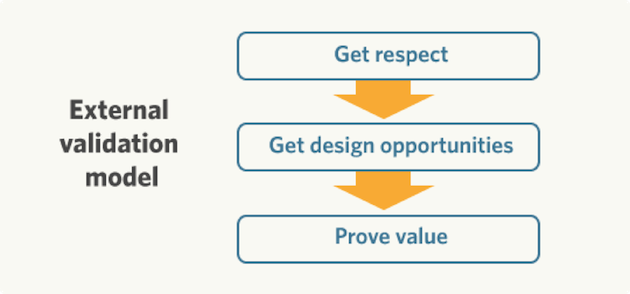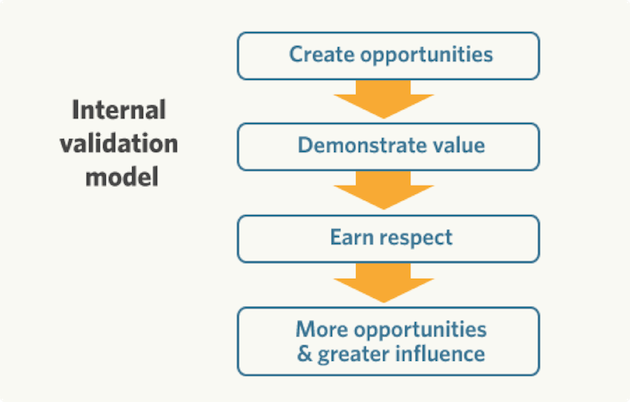Both design communities I’ve been involved in (graphic design and user experience design) spend an inordinate amount of energy bemoaning the lack of respect designers get and how misunderstood our value is.
Perhaps you’ve heard or even uttered statements like this:
I always include user research in my proposals, but clients never want to pay for it.
Nobody in our company understands what we do. They think we’re just here to build wireframes and make things look pretty.
If I could convince management how important design is, they’d involve us earlier in the process and we could have more influence on the direction of the product.
Not surprisingly, there is no shortage of articles and blog posts about how to communicate the value of UX. We’re told to learn how to speak to business people in terms they understand, like ROI and customer retention. We’re told to point to case studies like Jared Spool’s $300 million button in an effort to convince project managers that UX up front will save time and resources later due to fewer specification changes and faster implementation.
Many of us have been drawn into the “define the damn thing” debate. The industry needs to agree on a single definition, the argument goes, otherwise we’ll never be taken seriously. Present a unified, coherent story to business leaders and, in theory, they’ll recognize our value and give us a seat at the table.
If only people understood us, we’d get the respect we deserve, right? But how do we make ourselves understood?
The External Validation Model
If we model this strategy, it looks something like this:
The problem with this strategy is we’re stuck in step 1—endlessly explaining, getting nowhere, and waiting like wallflowers to be asked to dance.
I ought to know—I spent years as a consultant fruitlessly trying to convince clients to spend money on things like the discovery phase, user interviews, and usability testing. I knew this stuff was important because I’d read a lot of books and articles and had gone to a lot of conferences. Moreover, I knew that I couldn’t claim to be a “real” UX designer unless I was doing this stuff.
Here’s the ugly truth: I wanted clients to pay me to do user research in order to cement my credentials, not because I truly understood its value. How could I understand it? I’d never tried it, because I was waiting for permission.
The problem with the external validation model is that it puts success out of our control and into the hands of our clients, bosses, and managers. It creates a culture of learned helplessness and a childish “poor me” attitude that frequently manifests in withering scorn for clients and executives—the very people upon whom our livelihood depends.
The Internal Validation Model
The great thing about being a designer is that if I don’t like how a thing works, I can design something different. The external validation model clearly doesn’t work so I’ve decided to try something else, something I’m calling the “internal validation model.”
Without the conviction born of personal experience, all the explaining in the world won’t get us what we want. Get that experience, and you will start to respect yourself and your skills, instead of relying on others to validate you. This confidence will give you the courage to act first, and get permission later. Confident actions are what win respect and trust. The more we repeat steps 1 through 3, the greater our influence and the more opportunities we will have.
Create Opportunities
The first, crucial step in this process is to create opportunities instead of waiting for them to be handed to you. How do you create opportunities? Here are a few ideas:
1. Stop comparing. If you’ve been persuaded that there is such a thing as “real UX” and that there are prescribed techniques and tools you must use before you can call yourself a user experience designer, eradicate that thinking right now. Steve Krug will not laugh at you if you’re only able to do usability testing with your mom or the guy in the next cube. In fact, most of your peers will admire that you made the effort.
2. Don’t wait for permission. If you have to do UX on the sly, without getting paid, then so be it. What’s the worst thing that could happen? It’s unlikely you’ll be called on the carpet for trying to uncover usability issues everyone agrees need to be fixed. If you do get in trouble, your defense should always be that you’re doing what’s right for the project. No reasonable manager or client can object to this motive, they can only argue with your methods—at which point you have an opening to question a process that forced you to use stealth the first place.
3. Lower your sights. Offer to help in small ways, rather than insisting on implementing your full process. Of course you’d love to redesign the whole intranet, but the client only has a week. Do a heuristic review and find quick, visible wins that are easy to implement. You’ll prove you know what you’re doing and, more importantly, that you’re flexible and easy to work with.
4. Offer to facilitate meetings. Everyone hates meetings, especially planning meetings. There are always too many people, no agenda, and a whole lot of arguing with few results. Usually, whoever called the meeting is a stakeholder and they’re too involved to control the debate. What this meeting needs is a facilitator, a neutral third party to keep the discussion productive and moving forward. By lucky coincidence, user experience has a dozen techniques for getting ideas out, prioritizing and grouping them, getting agreement on action items, and keeping everyone engaged and participating. By offering to facilitate, you’ve relieved the meeting organizer of a burdensome role, you’ve provided an extremely useful and visible service to the team, and you’re getting a front-row seat at the kickoff of new work.
5. Find the dysfunction. Any dysfunction in the workplace can be a design opportunity. Poor communication, lousy documentation, morale issues, confusing signage—talk about obvious places to improve user experience in the workplace! Some of these issues are difficult to get to the root of, which is exactly why no one else wants to tackle them. But as UX designers, we should be thrilled. How many of us feel like we don’t get enough access to users? If you’re solving UX problems at your company, users are all around you. Contextual research, surveys, task analysis, affinity diagramming—all these methods can be used to understand, analyze, and design solutions to workplace dysfunction.
6. Look outside UX. Is your company looking for volunteers to sit on a search committee or to help evaluate insurance plans? Believe it or not, these are opportunities for design. Once on the committee, you have a chance to use UX techniques to help guide research, discussion, and the eventual communication of the results to everyone else. Plus, you’re making valuable connections across the company.
Demonstrate and Internalize Value
Demonstrate value every chance you get. Not just the value of design deliverables, but the value of design thinking and your value in particular. Do things that help people—that is what will win respect and trust. Once you have that trust, you can ask for the work you want. Although chances are you won’t have to. The work will come to you because you’ve not only proven to your team that UX is worthwhile, you’ve proven it to yourself. Now you have the confidence and conviction to speak more fluently and persuasively about it.
For example, what if you said to a new client, “I’d like to do a card sort before we start the wireframes because I think it will help us with [these problems]. It’ll only take a few hours. If you feel afterwards that it wasn’t valuable, I won’t charge you.”
If the card sort is a success, you get valuable experience that you can leverage into more UX with the next client or on the next job with the same client. If it doesn’t work, you still get valuable experience because you can analyze what didn’t work about it. Maybe card sorting wasn’t the right tool for the problem. Maybe you didn’t have the right participants, or enough of them. Maybe you didn’t do a good job communicating the results of the exercise. The point is, now you’ve got first-hand experience of what works and what doesn’t and you’ll be that much more confident and compelling the next time.
Conclusion
The external validation model ensures that we’re always arguing from a position of weakness—begging for resources before our managers or clients have seen what they’re buying.
We need to have the conversation about value after we’ve proven that the UX process works, not before. Think about the difference between saying, “Please give me resources to do three days of user research because it’s really, really important,” versus, “We did some quick, informal research and uncovered three major usability issues, so I’d like to talk to a few more users to validate these results.”
Actions are stronger than words. We have the power to break the cycle of learned helplessness and earn the respect we crave—if we stop explaining UX and start doing UX.
Image of idyllic dock courtesy Shutterstock.









